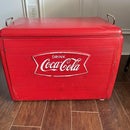Introduction: Pitch-A-Table
Everybody needs an extra occasional table, especially if the party extends to the grassy area of your yard. Although it looks ridiculous in the photo, as it is early spring here and the yard is still snow covered, it will be a great conversation piece once summer is here. Practical too as it uses a standard garden fork. If you don't have one, they can be bought at your local garden centre. Mine is an antique I inherited from my grandfather. I didn't want to ruin it so I designed the table to be built in two halves so it could be clamped to the handle of the fork. In that way, it allows the tool to be used for its intended purpose without altering it. Also it lets you adjust the height of the table. Since the tines of the fork support the table by being stuck in your lawn, it makes the table very sturdy. As a bonus it helps aerate your lawn without ruining it in any way.
Step 1: Prepare Your Material
I made everything from one 4 foot piece of 1"x10" pine. I used what I had on hand but cedar would probably have been a better choice since this will be used outside. I measured the wood to yield four 4"x 16" pieces. I left two pieces rectangular and bevelled the ends of the other two at 45 degrees to give the table top a modified octagonal shape. I also cut six 1,1/8"x 16" pieces, of which I actually only used four.
I clamped the two large rectangular pieces together, measured the centre and used a hole saw to drill a hole the exact diameter of the garden fork handle. If you are unsure of the size, go one diameter smaller as you can always sand it to fit exactly.
At this point I sanded everything and cleaned up all the edges.
Step 2: Assembly and Clamping Mechanism
The idea is to make two matching half tables.
Two of the 1,1/8"x16" pieces should be drilled about 3" from the centre. This will accommodate the two bolts that are used to clamp the halves together. I used two 1/4"x 4" carriage bolts, each with a matching washer and wing nut. You should drill the holes one size larger than the diameter of your bolts. I also bevelled the ends of the pieces at 45 degrees.
Attach the drilled pieces to the rectangular 4"x 16" pieces in a straight line corresponding to the edge of the handle hole. I used waterproof glue and brad nails. Lay the bevelled 4"x 16" pieces beside each rectangular piece, leaving a slight gap. From the remaining wood, make four 1,1/8"x 6" pieces and attach these as well to hold the rest of the table halves together.
Push the carriage bolts through the holes in one table half so the heads of the bolts fit flush against the wood. Then fasten the two halves around the fork handle by pushing the threaded ends of the bolts into the holes in the other table half. Tighten the wing nuts until you achieve a good friction fit. If you need to adjust the table height, just loosen the wing nuts and slide the table up or down.
You can always remove the table if you want to use the garden fork for its intended purpose.













